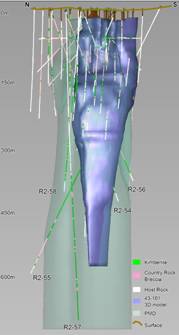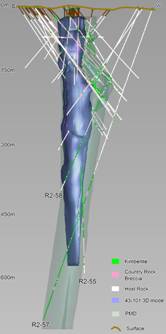Stornoway Diamond Corporation (TSX-SWY) is pleased to announce the completion of a highly successful winter drill program on the Renard 2 and Renard 3 kimberlite pipes, located at the Renard Diamond Project in North Central Québec. The Renard Diamond Project, which includes the Renard kimberlite pipes and the Lynx-Hibou system of kimberlite dykes, is a 50:50 joint venture with SOQUEM INC. ("SOQUEM").
The drilling has confirmed a significantly expanded zone of kimberlite on the northern and eastern sides of Renard 2 at depths greater than 250 meters below surface (see illustration below). Stornoway first announced the discovery of this new zone on March 9th. Three separate deep drill holes have now delineated the zone in the north-south and east-west axes, prompting a re-evaluation of the geological model for the overall pipe. It now appears that Renard 2 is approximately twice as large as previously thought when modeled to a depth of 570 meters below surface, which represents the base of the geological model used in the recent National Instrument ("NI") 43-101 compliant mineral resource statement (Stornoway Press Release dated December 15, 2008). The pipe is approximately three times larger than previously thought when modeled to a depth of 700 meters below surface.
Matt Manson, President and CEO commented: "What has been discovered is a substantial amount of new kimberlite at Renard 2 which has had a dramatic impact on our estimate of the overall size of the pipe. In the recently released Renard Preliminary Assessment, Renard 2 contributed the bulk of the mineral resource contained within the conceptual mine plan. The discovery of such a large amount of new kimberlite, much of it within the scope of the existing underground mine design, is expected to have a very positive impact on project economics. We are now planning the additional work programs required to convert this new material to a mineral resource. This important discovery follows the recent announcement by the Québec government of major capital funding for the ‘Route 167 Extension', the infrastructure project designed to provide year-round road access to the Renard project site."
In total, five deep delineation drill holes have been completed at Renard 2 as part of the winter drill program. Drill hole R2-55, which was previously reported (Stornoway Press Release dated March 9, 2009), gave an intersection of kimberlite on the northern side of the pipe 178 meters longer than expected from the existing geological model. Drill holes R2-57 and R2-58 were designed to provide the east-west dimension of this new extension, and returned kimberlite intersections of 339 meters and 250 meters respectively. Drill hole R2-57 ended in kimberlite at 729 meters due to drilling difficulties, and did not determine the actual eastern contact of the pipe at depth. Drill hole R2-58 includes a 56m intersection of dilute kimberlite (country rock plus kimberlite as shown on the illustration). These drill intersections, taken together with the existing drill database, are consistent with Renard 2 measuring approximately 180 meters by 50 meters (north-south and east-west dimensions) at a depth of 400 meters below surface, and 195 meters by 45-60 meters at a depth of 570 meters below surface. In the previous geological modeling, the pipe dimensions at these depths were thought to be only 70 meters by 38 meters and 48 meters by 10 meters respectively. The pipe remains open below 700 meters.
|

|
|

|
|
Illustration: Three dimensional geological model for Renard 2 as utilized in the December 2008 NI 43-101 compliant mineral resource statement (solid), and as updated to show the potential mineral deposit following the recent drilling (transparent). Views are from the east (left) and south (right).The models show the relative location of the new drill holes discussed above, as well as historical drilling. Present surface is at about 510m above sea level with vertical scale as shown. Kimberlite intersections in green, brecciated country rock +/- kimberlite in pink, and country rock in white.
Click here for larger version
|
Preliminary field logging indicates that the new kimberlite intersections are comprised predominantly of lithologies seen elsewhere within Renard 2, including Brown Transitional Kimberlite Breccia ("Kimb2b"), Blue Tuffisitic Kimberlite Breccia ("Kimb2a"), Hypabyssal Kimberlite Breccia and Hypabyssal Kimberlite, along with rafts of Country Rock and Country Rock Breccia with Kimberlite.
In the recent NI 43-101 compliant mineral resource statement for the project, Renard 2 was estimated to contain 3.36 million tonnes of Indicated Mineral Resource (at an average grade of 81 carats per hundred tonnes, or "cpht") and 1.80 million tonnes of Inferred Mineral Resource (at an average grade of 86 cpht). At that time, upside identified at Renard 2 in the form of potential mineral deposit was an additional 2.5 to 7.1 million tonnes (calculated to a depth of 700 meters below surface) with grades estimated between 73 and 164 cpht. The potential mineral deposit was determined on the basis of known drill intersections of kimberlite for which insufficient diamond sampling existed to adequately estimate a diamond resource grade, or on the basis of the implied depth extent of the kimberlite pipes to 700 meters below surface, or on the basis of geological uncertainty in the definition of kimberlite geological models. The new drilling reported herein supports a better constrained geological model that is consistent with a revised potential mineral deposit estimated at between 10.5 and 12.3 million tonnes to 700 meters below surface, a substantial increase over the previous estimate.
The reader is cautioned that the new kimberlite material reported today, as well as any "potential mineral deposit", does not constitute a mineral resource, and it is uncertain if further exploration will result in it being delineated as a mineral resource. In addition, mineral resources are not mineral reserves and do not have demonstrated economic viability. Future work required to update the Renard mineral resource statement includes additional delineation drilling and the integration of the observed geological units within the new kimberlite zone into the overall resource model using detailed petrographic and microdiamond analysis.
Two drill holes were also successful in extending the dimension of the Renard 3 kimberlite pipe at depth on a more modest basis, while a third drill hole deviated from its planned location and did not intersect the pipe. Full drill results, including expected and actual drill intersections, are provided in the table below.
Hole
ID |
Azimuth
(degree)
|
Dip
(degree)
|
Length
(meters)
|
Kimberlite Contact (meters down hole)
|
|
|
Upper
|
Lower
|
|
Renard 2
|
|
R2-543
|
175
|
-70
|
453
|
Expected
|
164
|
425
|
|
Actual
|
179
|
433
|
|
Difference1
|
-15
|
+8
|
|
R2-553
|
354
|
-63
|
660
|
Expected
|
120
|
395
|
|
Actual
|
122
|
573
|
|
Difference1
|
-2
|
+178
|
|
R2-563
|
156
|
-67
|
411
|
Expected
|
152
|
312
|
|
Actual
|
109
|
393
|
|
Difference1
|
+43
|
+81
|
|
R2-57
|
094
|
-70
|
729
|
Expected
|
n/a
|
n/a
|
|
Actual
|
390
|
>7292
|
|
Difference1
|
Outside Extent of Previous Model
|
|
R2-58
|
078
|
-66
|
441
|
Expected
|
n/a
|
n/a
|
|
Actual
|
165
|
415
|
|
Difference1
|
Outside Extent of Previous Model
|
|
Renard 3
|
|
R3-56
|
130
|
-62
|
321
|
Expected
|
220
|
246
|
|
Actual
|
199
|
279
|
|
Difference1
|
+21
|
+33
|
|
R3-57
|
208
|
-67
|
447
|
Expected
|
347
|
387
|
|
Actual
|
Did Not Intersect Kimberlite Pipe
|
|
Difference1
|
|
R3-58
|
050
|
-76
|
325
|
Expected
|
240
|
267
|
|
Actual
|
232
|
291
|
|
Difference1
|
+8
|
+24
|
1 A negative ("-") difference indicates a decrease in geological model size when compared to the model utilized in the Dec 15th NI 43-101 compliant mineral resource statement. A positive ("+") indicates an increase in model size. Differences between expected and actual contacts have a smaller influence on the shape of the geological model at the top of the pipe than at the bottom owing to the amount of geological control already existing.
2 Hole ended in kimberlite. Terminated due to drilling difficulties.
3 Miinor revisions from March 09, 2009 release incorporating final geological logging and positional survey data.
Stornoway Diamond Corporation
Stornoway Diamond Corporation is one of Canada's leading diamond exploration and development companies, involved in the discovery of over 200 kimberlites in six Canadian diamond districts. The Company benefits from a diversified diamond property portfolio, a strong financial platform and management and technical teams with experience in each segment of the diamond "pipeline" from exploration to marketing. The Renard Diamond Project is managed by Dave Skelton, P. Geol. (AB/QC), Vice President, Project Development. Mr. Skelton is a Qualified Person under NI 43-101 and has reviewed the contents of this press release.
SOQUEM INC.
SOQUEM is a wholly-owned subsidiary of Société générale de financement du Québec ("SGF"). The SGF, the Québec industrial and financial holding company, has as its mission to undertake economic development projects in the industrial sector in cooperation with partners and in compliance with the economic development policies of the Government of Québec.
On behalf of the Board
STORNOWAY DIAMOND CORPORATION
/s/ "Matt Manson"
Matt Manson
President and Chief Executive Officer
For more information, please contact Matt Manson (President and CEO) at 416-304-1026
or Nick Thomas (Manager Investor Relations) at 604-983-7754 or toll free at 1-877-331-2232
** Website: www.stornowaydiamonds.com Email: info@stornowaydiamonds.com **
This news release may contain forward looking statements, being statements which are not historical facts, including, without limitation, statements regarding potential mineralization, exploration results, resource or reserve estimates, anticipated production or results, sales, revenues, costs, "best-efforts" financings or discussions of future plans and objectives. There can be no assurance that such statements will prove accurate. Such statements are necessarily based upon a number of estimates and assumptions that are subject to numerous risks and uncertainties that could cause actual results and future events to differ materially from those anticipated or projected. Any statements made regarding a NI 43-101 Preliminary Assessment of a project includes inferred mineral resources that are considered too speculative geologically to have the economic considerations applied to them that would enable them to be categorized as mineral reserves, and there is no certainty that the Preliminary Assessment will be realized. References to NI 43-101 Resource Calculations are Mineral Resources and are not Mineral Reserves and therefore do not have demonstrated economic viability. Important factors that could cause actual results to differ materially from the Company's expectations are in Company documents filed from time to time with the Toronto Stock Exchange and provincial securities regulators, most of which are available at www.sedar.com. The Company disclaims any intention or obligation to revise or update such statements.